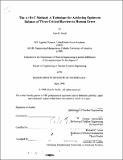| dc.contributor.advisor | George Apostolakis. | en_US |
| dc.contributor.author | Smith, Alan B. (Alan Bartow), 1961- | en_US |
| dc.date.accessioned | 2010-01-07T20:46:01Z | |
| dc.date.available | 2010-01-07T20:46:01Z | |
| dc.date.copyright | 1998 | en_US |
| dc.date.issued | 1998 | en_US |
| dc.identifier.uri | http://hdl.handle.net/1721.1/50497 | |
| dc.description | Thesis (M.Eng.)--Massachusetts Institute of Technology, Dept. of Nuclear Engineering, 1998. | en_US |
| dc.description | Includes bibliographical references (leaves 51-52). | en_US |
| dc.description.abstract | After thirty years of commercial nuclear plant operation, the nuclear industry has achieved dramatic improvements in the safe and reliable operation of its electrical generating stations. Recent indications, however, are that the rate of improvement may be slowing, particularly in the area of human performance. The nuclear industry has been and will be heavily dependent on rigid structure and centralized organization. Defense- in- depth is a key element in the prevention of human error or equipment malfunction and will continue to be so. The accident at Three Mile Island significantly increased the emphasis placed on procedures as a means of preventing human error. However, current reductions in the rate of human performance improvement have prompted reevaluation of the ability of improvement techniques, which have unquestionably achieved noteworthy success in the past, to enjoy similar success in the future. Years of adding more and more detail to procedures may in fact be becoming counterproductive. The majority of work on procedure use and procedure violations that has been performed to date deals primarily with the psychological aspects of human behavior. The ability of the procedure user to follow the procedure without becoming confused, however, has been left relatively unanalyzed. This paper attempts to characterize the recent slowdown in human performance improvement and the dynamics associated with human performance, to ascertain the significance of procedure complexity, and to put forward a technique to achieve an optimum balance of the critical factors that constitute human error defense-indepth. The embodiment of the technique, referred to as the A + B + C Method, is a mnemonic to allow workers and supervisors to balance the level of procedure detail, the worker's level of knowledge, and the amount of supervisory involvement required when executing work tasks. | en_US |
| dc.description.statementofresponsibility | by Alan B. Smith. | en_US |
| dc.format.extent | 54 leaves | en_US |
| dc.language.iso | eng | en_US |
| dc.publisher | Massachusetts Institute of Technology | en_US |
| dc.rights | M.I.T. theses are protected by
copyright. They may be viewed from this source for any purpose, but
reproduction or distribution in any format is prohibited without written
permission. See provided URL for inquiries about permission. | en_US |
| dc.rights.uri | http://dspace.mit.edu/handle/1721.1/7582 | en_US |
| dc.subject | Nuclear Engineering | en_US |
| dc.title | The A+B+C+ Method : a technique for achieving optimum balance of three critical barriers to human error | en_US |
| dc.title.alternative | A plus B plus C plus Method | en_US |
| dc.title.alternative | Technique for achieving optimum balance of three critical barriers to human error | en_US |
| dc.type | Thesis | en_US |
| dc.description.degree | M.Eng. | en_US |
| dc.contributor.department | Massachusetts Institute of Technology. Department of Nuclear Science and Engineering | en_US |
| dc.identifier.oclc | 42256356 | en_US |

